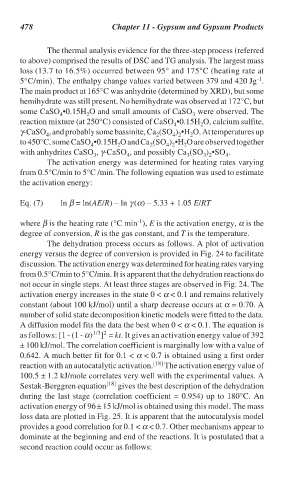Page 506 - Handbook of Thermal Analysis of Construction Materials
P. 506
478 Chapter 11 - Gypsum and Gypsum Products
The thermal analysis evidence for the three-step process (referred
to above) comprised the results of DSC and TG analysis. The largest mass
loss (13.7 to 16.5%) occurred between 95° and 175°C (heating rate at
-1
5°C/min). The enthalpy change values varied between 379 and 420 Jg .
The main product at 165°C was anhydrite (determined by XRD), but some
hemihydrate was still present. No hemihydrate was observed at 172°C, but
some CaSO •0.15H O and small amounts of CaSO were observed. The
3
2
4
reaction mixture (at 250°C) consisted of CaSO •0.15H O, calcium sulfite,
4
2
γ-CaSO , and probably some bassinite, Ca (SO ) •H O. At temperatures up
2
2
4 2
4
to 450°C, some CaSO •0.15H O and Ca (SO ) •H O are observed together
2
2
4 2
2
4
with anhydrites CaSO , γ-CaSO , and possibly Ca (SO ) •SO .
4
4
3 2
3
3
The activation energy was determined for heating rates varying
from 0.5°C/min to 5°C /min. The following equation was used to estimate
the activation energy:
Eq. (7) ln β = ln(AE/R) – ln γ (α) – 5.33 + 1.05 E/RT
-1
where β is the heating rate (°C min ), E is the activation energy, α is the
degree of conversion, R is the gas constant, and T is the temperature.
The dehydration process occurs as follows. A plot of activation
energy versus the degree of conversion is provided in Fig. 24 to facilitate
discussion. The activation energy was determined for heating rates varying
from 0.5°C/min to 5°C/min. It is apparent that the dehydration reactions do
not occur in single steps. At least three stages are observed in Fig. 24. The
activation energy increases in the state 0 < α < 0.1 and remains relatively
constant (about 100 kJ/mol) until a sharp decrease occurs at α = 0.70. A
number of solid state decomposition kinetic models were fitted to the data.
A diffusion model fits the data the best when 0 < α < 0.1. The equation is
1/3 2
as follows: [1 - (1 - α) ] = kt. It gives an activation energy value of 392
± 100 kJ/mol. The correlation coefficient is marginally low with a value of
0.642. A much better fit for 0.1 < α < 0.7 is obtained using a first order
reaction with an autocatalytic activation. [18] The activation energy value of
100.5 ± 1.2 kJ/mole correlates very well with the experimental values. A
Sestak-Berggren equation [18] gives the best description of the dehydration
during the last stage (correlation coefficient = 0.954) up to 180°C. An
activation energy of 96 ± 15 kJ/mol is obtained using this model. The mass
loss data are plotted in Fig. 25. It is apparent that the autocatalysis model
provides a good correlation for 0.1 < α < 0.7. Other mechanisms appear to
dominate at the beginning and end of the reactions. It is postulated that a
second reaction could occur as follows:

